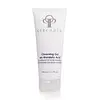What's inside
What's inside
 Key Ingredients
Key Ingredients

 Benefits
Benefits

 Concerns
Concerns

 Ingredients Side-by-side
Ingredients Side-by-side

Water
Skin ConditioningSodium C14-16 Olefin Sulfonate
CleansingCocamidopropyl Betaine
CleansingMandelic Acid
AntimicrobialSodium Chloride
MaskingPanthenol
Skin ConditioningCaprylyl Glucoside
CleansingMaltodextrin
AbsorbentCamellia Sinensis Leaf Extract
AntimicrobialCaffeine
Skin ConditioningCitrus Limon Fruit Extract
MaskingLavandula Angustifolia Flower/Leaf/Stem Extract
MaskingCitrus Aurantium Bergamia Fruit Oil
MaskingMalus Domestica Fruit Extract
AntioxidantCitric Acid
BufferingVanilla Planifolia Fruit Extract
Skin ConditioningRosmarinus Officinalis Leaf Extract
AntimicrobialSalvia Officinalis Oil
MaskingRosmarinus Officinalis Leaf Oil
MaskingLavandula Hybrida Oil
EmollientSalvia Sclarea Oil
Masking1,2-Hexanediol
Skin ConditioningCaprylyl Glycol
EmollientPolysorbate 20
EmulsifyingSodium Hydroxide
BufferingWater, Sodium C14-16 Olefin Sulfonate, Cocamidopropyl Betaine, Mandelic Acid, Sodium Chloride, Panthenol, Caprylyl Glucoside, Maltodextrin, Camellia Sinensis Leaf Extract, Caffeine, Citrus Limon Fruit Extract, Lavandula Angustifolia Flower/Leaf/Stem Extract, Citrus Aurantium Bergamia Fruit Oil, Malus Domestica Fruit Extract, Citric Acid, Vanilla Planifolia Fruit Extract, Rosmarinus Officinalis Leaf Extract, Salvia Officinalis Oil, Rosmarinus Officinalis Leaf Oil, Lavandula Hybrida Oil, Salvia Sclarea Oil, 1,2-Hexanediol, Caprylyl Glycol, Polysorbate 20, Sodium Hydroxide
Water
Skin ConditioningCocamidopropyl Betaine
CleansingSodium C14-16 Olefin Sulfonate
CleansingMethyl Gluceth-20
HumectantPPG-26-Buteth-26
Skin ConditioningPEG-40 Hydrogenated Castor Oil
EmulsifyingButylene Glycol
HumectantCimicifuga Racemosa Root Extract
AntimicrobialCamellia Oleifera Leaf Extract
AstringentSilver Citrate
AntimicrobialMenthol
MaskingPEG-150 Distearate
EmulsifyingZea Mays Starch
AbsorbentHydrolyzed Corn Starch
HumectantHydrolyzed Corn Starch Octenylsuccinate
AbsorbentGlyceryl Stearate
EmollientCocamidopropyl Dimethylamine
EmulsifyingPolysorbate 80
EmulsifyingCitric Acid
BufferingTetrasodium EDTA
Chlorphenesin
AntimicrobialMethylisothiazolinone
PreservativeLimonene
PerfumingAngelica Archangelica Leaf Oil
PerfumingCymbopogon Nardus Oil
MaskingCitrus Limon Peel Oil
MaskingCitrus Aurantifolia Oil
CleansingLavandula Hybrida Oil
EmollientCitrus Aurantium Dulcis Peel Oil
MaskingPrunus Armeniaca Kernel Oil
MaskingParfum
MaskingWater, Cocamidopropyl Betaine, Sodium C14-16 Olefin Sulfonate, Methyl Gluceth-20, PPG-26-Buteth-26, PEG-40 Hydrogenated Castor Oil, Butylene Glycol, Cimicifuga Racemosa Root Extract, Camellia Oleifera Leaf Extract, Silver Citrate, Menthol, PEG-150 Distearate, Zea Mays Starch, Hydrolyzed Corn Starch, Hydrolyzed Corn Starch Octenylsuccinate, Glyceryl Stearate, Cocamidopropyl Dimethylamine, Polysorbate 80, Citric Acid, Tetrasodium EDTA, Chlorphenesin, Methylisothiazolinone, Limonene, Angelica Archangelica Leaf Oil, Cymbopogon Nardus Oil, Citrus Limon Peel Oil, Citrus Aurantifolia Oil, Lavandula Hybrida Oil, Citrus Aurantium Dulcis Peel Oil, Prunus Armeniaca Kernel Oil, Parfum
 Reviews
Reviews

Ingredients Explained
These ingredients are found in both products.
Ingredients higher up in an ingredient list are typically present in a larger amount.
Citric Acid is an alpha hydroxy acid (AHA) naturally found in citrus fruits like oranges, lemons, and limes.
Like other AHAs, citric acid can exfoliate skin by breaking down the bonds that hold dead skin cells together. This helps reveal smoother and brighter skin underneath.
However, this exfoliating effect only happens at high concentrations (20%) which can be hard to find in cosmetic products.
Due to this, citric acid is usually included in small amounts as a pH adjuster. This helps keep products slightly more acidic and compatible with skin's natural pH.
In skincare formulas, citric acid can:
While it can provide some skin benefits, research shows lactic acid and glycolic acid are generally more effective and less irritating exfoliants.
Most citric acid used in skincare today is made by fermenting sugars (usually from molasses). This synthetic version is identical to the natural citrus form but easier to stabilize and use in formulations.
Read more about some other popular AHA's here:
Learn more about Citric AcidCocamidopropyl Betaine is a fatty acid created by mixing similar compounds in coconut oil and dimethylaminopropylamine, a compound with two amino groups.
This ingredient is a surfactant and cleanser. It helps gather the dirt, pollutants, and other impurities in your skin to be washed away. It also helps thicken a product and make the texture more creamy.
Being created from coconut oil means Cocamidopropyl Betaine is hydrating for the skin.
While Cocamidopropyl Betaine was believed to be an allergen, a study from 2012 disproved this. It found two compounds in unpure Cocamidopropyl Betaine to be the irritants: aminoamide and 3-dimethylaminopropylamine. High-grade and pure Cocamidopropyl Betaine did not induce allergic reactions during this study.
Learn more about Cocamidopropyl BetaineLavandula Hybrida Oil is an oil.
Sodium C14-16 Olefin Sulfonate is a cleansing agent made from a mixture of long chain sulfonate salts. It can also help produce foam.
This ingredient may be drying. We recommend speaking with a professional if you have concerns.
Water. It's the most common cosmetic ingredient of all. You'll usually see it at the top of ingredient lists, meaning that it makes up the largest part of the product.
So why is it so popular? Water most often acts as a solvent - this means that it helps dissolve other ingredients into the formulation.
You'll also recognize water as that liquid we all need to stay alive. If you see this, drink a glass of water. Stay hydrated!
Learn more about Water